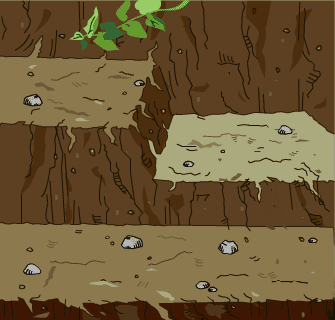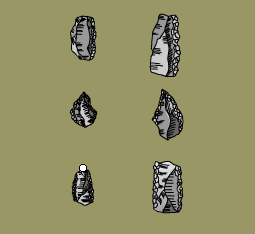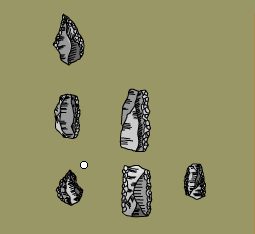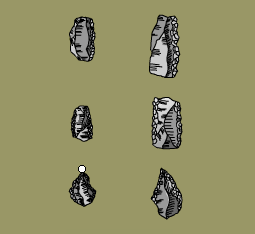|
 |
 |
|
Site 3

About this Site
This is an open-air site in western Germany.
Ten distinct layers have accumulated at this site over the millennia. You are excavating three of the ten layers.
Dig
You used your brush to expose six artifacts.

Deduce
The artifacts you have found are scrapers—stone tools used for tasks such as scraping hides and removing meat from bone.
Let's try to group these tools in some meaningful way. Here they've been sorted according to three types: single-edged, double-edged, and pointed. At other Neanderthal sites, there is some indication that only certain types of tools are found together. For example, some sites contain mainly single-edged scrapers and pointed scrapers while others contain mainly single-edged scrapers.
Some archeologists believe that the reason for different sets of tools is that they were produced and used by different groups of Neanderthals. Because these separate groups didn't interact, the unique designs of their tools were passed on through many generations.

What if we sorted the tools chronologically?
Now the scrapers are sorted according to the level you found them in, which is to say by their age. If we assume that this bed has not been disturbed through the ages, then we can also assume that layer after layer of new sediments (along with artifacts) have been deposited over time, and that the youngest layer is at the top and the oldest at the bottom.
If we look at the chronology of the tools (those unearthed here as well as elsewhere), time seems to be the factor that accounts for the variation, though the development, or sequence, of tools from site to site doesn't always match up. Anyway, some archeologists see three distinct technological cultures. (This variation is not apparent in the six tools you found.)

Some archeologists look at tools from a different perspective: They see a tool not as an end product, but rather as a stage in the tool's working existence.
The scrapers are now arranged from single-edged to double-edged to pointed. This illustrates, these archeologists argue, how a single tool is transformed while it's being used.
A tool started out as a single-edged scraper. When that edge became dull, its owner, instead of tossing it aside, sharpened its other edge. It would then be double-edged. And if its owner continued to sharpen its two edges, the tool's edges might eventually converge to produce a point. In other words, the type of tool we end up with depends on when, in it's life of being sharpened, its owner stopped using it.
Final Note
The scenario presented in this section is not based on the excavation at any one site in particular. There are many Neanderthal sites where all of the tools like the ones you uncovered have been found.
Most archeologists today believe that a Neanderthal's tool took on various shapes between the time he or she first produced it and the time he or she discarded it. This suggests that sorting by type is not particularly meaningful.
If you haven't already done so, there is more digging and deducing to be done at Site 1 and Site 2.
Casts of Characters |
Into the Fray |
Tracing Ancestry with MtDNA |
Dig and Deduce
Resources |
Teacher's Guide |
Transcript |
Site Map |
Neanderthals on Trial Home
Search |
Site Map |
Previously Featured |
Schedule |
Feedback |
Teachers |
Shop
Join Us/E-Mail |
About NOVA |
Editor's Picks |
Watch NOVAs online |
To print
PBS Online |
NOVA Online |
WGBH
© | Updated November 2001
|
|
|
|